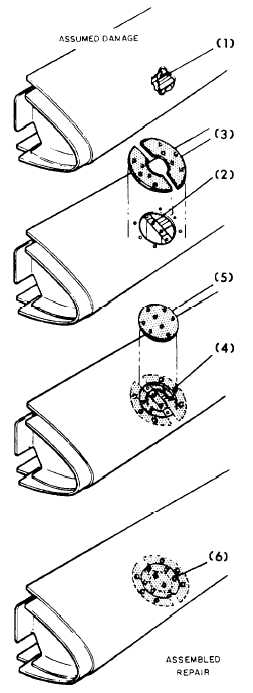On larger repair areas, it is usually possible to
buck the doubler rivets by inserting and holding the
bucking bar through the center of the doubler. The
filler is then riveted in place with blind fasteners.
When blind rivets are used as substitutes for solid
rivets, the structural repair manual normally specifies
the next larger size. The proper edge distances for the
substitute fasteners must be maintained.
NOTE: Edge distance was discussed earlier.
In all flushpatches, the filler should be of the
same gauge and material as the original skin.
The doubler, generally, should be of the same
material and one gauge heavier than the skin.
Structural repair manuals will specify the
allowable substitution of materials. This can
be in the form of a note on the repair diagram.
When you are laying out the size of the doubler,
the length should exceed the width. This enables the
doubler to be slipped in through the skin and
positioned for installation. This eliminates the
splitting and manipulation of the patch required in
installing doublers of square and round flush patch
repairs.
The filler is fabricated slightly less than the
dimensions of the hole being repaired. Generally, the
maximum clearance between the skin and the filler is
one thirty-second of an inch. This will allow a
1/64-inch clearance on each end of the filler and
eliminate any possibility of stress developing from
contact between the two parts. The doubler is
fabricated larger than the hole being repaired to allow
for the specified number of rivets required to attach
the doubler to the skin being repaired. The doubler,
filler, and attaching skin rivet pattern may be laid out,
drilled, and deburred in the identical manner as
described for a lap patch. After the required
corrosion-preventive materials have been applied, the
doubler is positioned in the structure’s interior and
secured with temporary fasteners. Inspect the rivet
holes for proper alignment, and rivet the doubler in
place with solid rivets. The filler can then be riveted
in place with blind fasteners.
NOTE: If the flush repair is in an open skin
area, the filler may be riveted to the doubler
prior to installing the doubler.
FLUSH PATCH OVER INTERNAL
STRUCTURES.—Fabricating a flush patch over
internal structures may become difficult. In some
instances, it may be done simply with a split doubler
and a filler, as shown in figure 13-62. Frequently a
split doubler, filler strips, and filler are used in the
repair. The filler strip is used as a spacer if a
structural component under the skin has been
damaged. In all cases, the existing structure’s rivet
holes should be used when the rivet pattern is laid out.
The flush patch over internal structure is installed
with the same methods as described for a flush patch
Figure 13-62.—Flush patch over internal structure.
13-45

